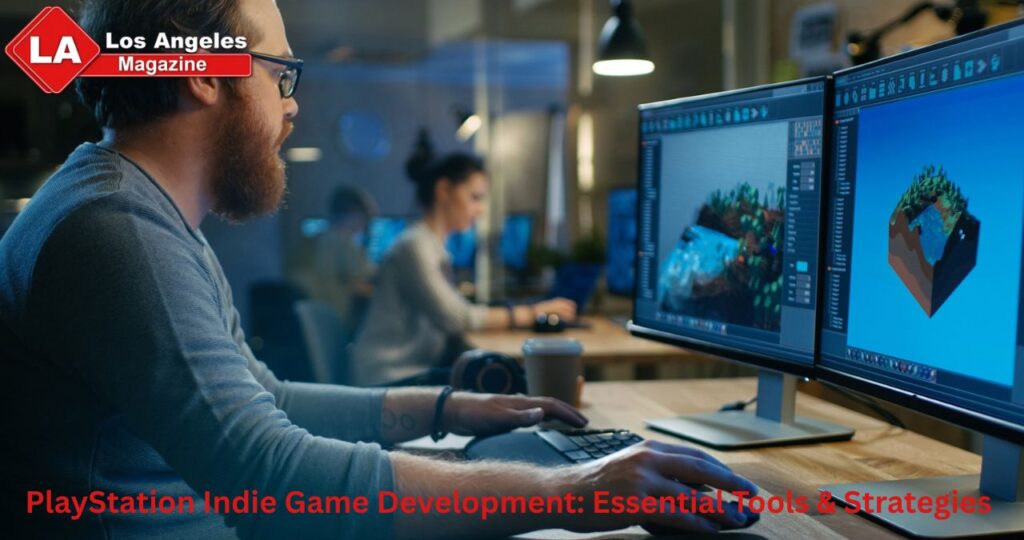The indie game scene has grown into something amazing over the past few years. It gives The indie game development sector is a dynamic and ever-evolving field that provides developers with a platform to explore unique narratives and innovative mechanics. Unlike AAA studios, indie developers often work with limited resources, but they enjoy the flexibility to experiment and take creative risks. This creative freedom has led to the rise of some of the most original and engaging games in recent years.
However, despite this freedom, indie developers face significant challenges in gaining visibility and market penetration—particularly when it comes to PlayStation game development. While developing for PlayStation offers massive opportunities thanks to its extensive global player base, the process involves strict licensing requirements, access to proprietary development kits, and passing Sony’s certification protocols. These complexities make it difficult for indie studios to break into the PlayStation market, even though it remains one of the most desirable platforms for indie success.
The Rise of Indie Games
Lately, indie games have started getting some real recognition in the gaming world. More and more players are looking for something fresh—stories and gameplay that go beyond the typical AAA formula. And that’s where indie games shine.
This shift in player interest is opening doors for small studios and solo devs to break into the scene. People want games that feel personal, different, and bold. Indie devs are in a great spot to deliver exactly that.
Financial Constraints and Resource Management
One of the most pressing challenges for indie game developers is managing financial constraints. Limited budgets often require developers to make strategic decisions about where to allocate resources, whether it’s investing in development tools, marketing efforts, or team expansion. Effective resource management is crucial in ensuring that a game is completed on time and meets quality expectations. Developers must often wear multiple hats, handling everything from coding to marketing, which can be both a challenge and an opportunity for personal and professional growth.
Visibility in a Saturated Market
Let’s be honest—just making a good game isn’t enough anymore. The market is overflowing with new releases. To stand out, you’ve got to think about how you present your game to the world.
That means creating a strong story around your game, being active on socials, getting influencers to notice you, and maybe even jumping into events and expos. The more people talking about your game, the better your chances of gaining traction.
Tools for PlayStation Indie Game Development
PlayStation SDK and Dev Kits
Sony provides a solid toolkit for developers through their SDK and Dev Kits. These resources include libraries, documentation, and all the backend stuff needed to get your game working smoothly on PlayStation hardware.
To access them, you’ll need to join Sony’s developer program—which isn’t a free-for-all. You’ll have to pitch your game, showing why it’s unique and what kind of potential it has. If Sony likes what they see, you’re in—and from there, you get access not just to tools, but also potential promotion opportunities within PlayStation’s ecosystem.
Middleware and Game Engines
Along with the official SDK, you’ve got powerful game engines like Unity and Unreal Engine. These are favorites among indie devs because they’re flexible, well-supported, and come with tons of features out of the box.
Middleware tools can save time and money by handling tricky systems like physics or audio. That means more time for you to focus on game design and creativity. Plus, if you ever hit a wall, chances are someone in the huge communities around these tools has already figured out the solution.
Importance of Technical Proficiency
Having access to fancy tools is one thing—but knowing how to use them is where the magic happens. It’s not enough to just plug into the SDK. You need to understand how PlayStation hardware works, how to optimize your game for performance, and how to hit all the technical requirements.
The more comfortable you are with the tech side, the smoother your development process will be—and the higher your chances of passing certification with flying colors.
Licensing for Indie Games on PlayStation
The Licensing Process
Getting licensed for PlayStation is a big deal. It’s not just a legal formality—it’s the gateway to publishing your game on the PlayStation Store.
You’ll need to submit a detailed proposal, show your technical know-how, and prove your game can meet Sony’s standards. That means plenty of documentation, testing, and maybe a few rounds of feedback from Sony’s team. Be ready to make changes if needed. Flexibility goes a long way here.
Legal and Financial Considerations
Don’t forget the legal side. You need full rights to any third-party content in your game—music, fonts, engine plugins, anything. On top of that, make sure you understand how revenue sharing works and what kind of fees might come with being on the platform.
Talking openly with Sony’s team can help you avoid unpleasant surprises down the road. Being clear on the business side is just as important as nailing the creative.
Compliance and Quality Assurance
Sony has high standards. Before your game hits the store, it’ll go through testing for bugs, crashes, and performance issues. And that testing doesn’t stop once the game launches—ongoing updates and support are expected.
Meeting these benchmarks shows that you take your game (and your players) seriously. It builds trust and increases your chances of long-term success.
Market Access and Indie Game Success on PlayStation
Indie Game Marketing Strategies
Marketing isn’t just about ads. For indie games, it’s about building a vibe, a story, a presence. Start with a solid website, be active on social media, and tell people what makes your game special.
Partnering with streamers or YouTubers can give you that extra push. Show your game at expos if you can. Even a short demo or beta can get people talking. If players feel connected before launch, you’re off to a great start.
The Role of Community Engagement
Your community isn’t just your audience—they’re your allies. Engage with them. Answer questions. Ask for feedback. Share updates.
When people feel like they’re part of your journey, they’re more likely to support you—and tell others to do the same. Some devs even bring fans into the process through beta testing or contests for in-game content. That connection can turn a small following into a dedicated fanbase.
Leveraging Data and Analytics
Paying attention to the numbers can really help. Track how players are interacting with your game. What are they loving? Where are they getting stuck or dropping off?
Data can help you fine-tune your game and guide your marketing. It doesn’t replace creativity—but it’s a powerful tool to help your decisions be more informed and effective.
Case Studies: Indie Success Stories on PlayStation
Journey: A Narrative Triumph
Thatgamecompany’s Journey is one of the most iconic indie successes on PlayStation. It didn’t rely on traditional mechanics. Instead, it offered a quiet, emotional experience that felt more like interactive art.
With strong creative direction and smart partnerships, Journey built a reputation as something totally unique. It showed that a small game with a big heart could make a massive impact.
Hollow Knight: Building a Community
Hollow Knight from Team Cherry is a different kind of indie win. It built its following through community engagement and consistently strong updates.
Players connected with its deep lore and challenging gameplay, but it was the way the devs stayed in touch with fans that really stood out. They listened, responded, and made players feel like part of the adventure. That support turned Hollow Knight into a fan favorite and a commercial hit.
Lessons from Successful Indie Games
So what can we learn from games like Journey and Hollow Knight? A lot. Story matters. So does community. And partnerships can open doors that are hard to walk through alone.
If you can tell a story worth hearing, involve your players, and stay open to learning and adapting—you’ve got a real shot at creating something special.
Final Thoughts
Breaking into PlayStation as an indie developer isn’t easy. But it’s totally possible with the right tools, licenses, and mindset.
Learn the tech. Respect the business side. Build a game that speaks to people—and then shout about it in every corner of the internet. Partner wisely. Talk to your community. Stay humble and keep pushing.
There’s no perfect formula. But if you keep growing, keep experimenting, and keep listening—you might just create the next big indie hit on PlayStation.



